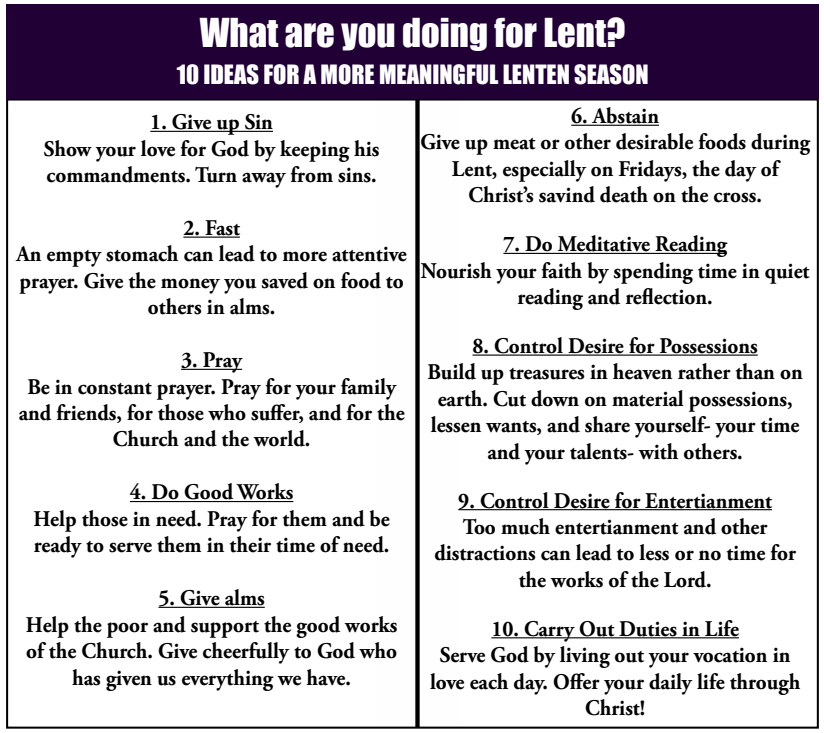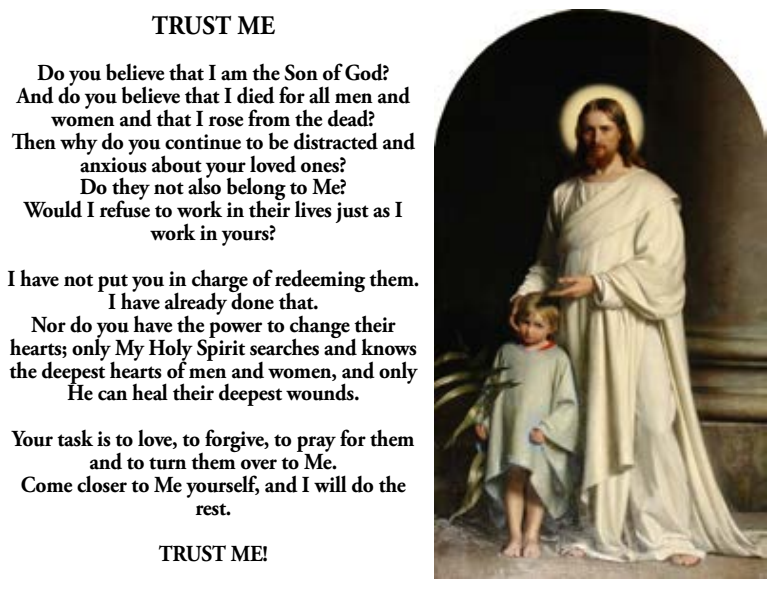
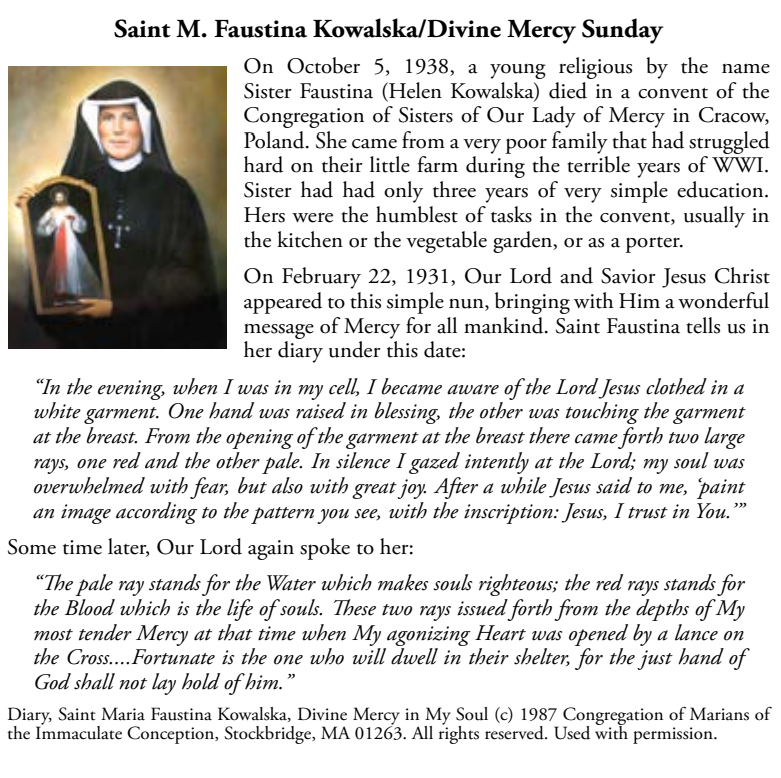
Mary is prostrated with Her face on the floor. She looks like a poor wretch. She looks like that withered flower of which She has spoken.
The closed window is opened with a violent banging of the heavy shutters, and with the first ray of the sun, Jesus enters.
Mary, Who has been shaken by the noise and has raised Her head to see which wind has opened the shutters, sees Her radiant Son: handsome, infinitely more handsome than He was before suffering, smiling lively, brighter than the sun, dressed in a white garment that seems woven light, and Who is advancing toward Her.
She straightens Herself up on Her knees and crossing Her hands on Her breast, She says with a sob that is joy and grief, “Lord, My God.” And She remains thus, enraptured in contemplating Him, with Her face all washed by tears, but made serene, pacified by His smile and by the ecstasy.
But He does not want to see His Mother on Her knees, like a servant. And He calls Her, stretching out His hands from the wounds of which emanate rays that make His glorious Flesh even brighter: Mother! But it is not the sorrowful word of the conversations and the farewells before His Passion, or the heart-rending lament of the meeting on Calvary and of the agony. It is a cry of triumph, of joy, of freedom, of rejoicing, of love, of gratitude. And He bends over His Mother, lifts Her up, He presses Her to His Heart and kisses Her.
Mary realises then that it is not a vision, that it is Her Son Who has really risen, that it is Her Jesus, the Son Who still loves Her as a Son. And with a cry, She flings Her arms round His neck, and She embraces and kisses Him, laughing in Her weeping. She kisses His Forehead, where there are no longer any wounds, His Head no longer unkempt and bloody, His shining Eyes, His healed Cheeks, His Mouth no longer swollen. She then takes His Hands and kisses their backs and palms, their radiant wounds, and She suddenly bends down to His Feet and uncovers them from under His bright garment and kisses them. Then She stands up, looks at Him, but dares not.
But He smiles and understands. He uncovers His chest a little and says, “And this one, Mother, are You not kissing it, this one that grieved You so much and that You alone are worthy to kiss? Kiss my Heart, Mother. Your kiss will cancel the last remberance of what is sorrowful and will give Me that joy, which My Joy of having risen from the dead still lacks.” And He takes the face of His Mother in His Hands and He lays Her lips on the lips of the wound of His Chest, from which streams of a very bright light are flowing.
Mary’s face is haloed by that light, flooded as it is with its beams. She kisses and kisses, while Jesus caresses Her. She never tires kissing. She looks like a thirsty woman whose mouth is attached to a fountain and who drinks from it the life that was escaping her.
Jesus speaks now.
“It’s all over, Mother. You no longer have to weep over Your Son. The trial is over. Redemption has taken place.”
Taken from Poem of the Man-God Chapter 614
No matter what their color, almost all Miniature Donkeys share the distinctive mark of a cross that extends down their back and across their shoulders.
While genetics account for this coloration, poet Mary Singer has a more touching explanation:
The Donkey’s Cross
“Bring me a colt of a donkey,” was the Master’s request. A young donkey was brought to Jesus to bring Him to Jerusalem. A week later Jesus was ordered crucified.
The little donkey so loved the Lord that he wanted to help Him carry the cross.
But alas, he was pushed away.
The sad little donkey waited to say goodbye until nearly all had left.
As he turned to leave, the shadow of the cross fell on his back and shoulders.
And there it has remained, a tribute to the loyalty and love of one of the humblest of God’s creatures.
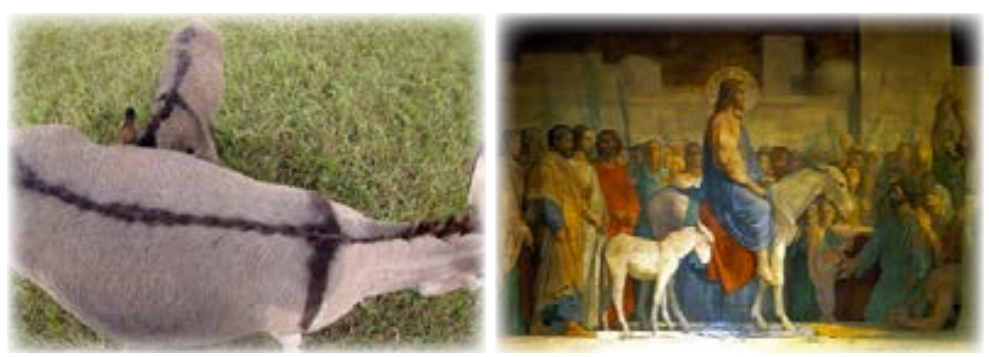
According to legend, the St. Joseph Altar originated in Sicily many centuries ago. During a period of desperate drought and famine, the Sicilian people turned to St. Joseph asking his help and intercession. When the rains came and crops prospered, their prayers were answered.
In thanksgiving, the community made offerings to St. Joseph of their most prized possession -FOOD! In his honor, they erected a lovely altar with three levels to represent the Holy Trinity. They draped it simply and beautifully in white, adorned it with flowers, the finest grain, fruits, vegetables, seafood and wine. The poor were invited to share in their prayer and festivity.
Even though at times it was a great sacrifice, the tradition continued as a labor of love and devotion on the feast day of St. Joseph, March 19th. At first the altars were erected in family homes, usually in thanksgiving for favors granted, such as deliverance from the ravages of war or the healing of body or spirit of a loved one. When the Sicilians emigrated to the United States over a century ago, they brought this custom with them. These altars flourished in the New Orleans areas where the tradition continues today.
There are many traditions associated with a St. Joseph Altar. One is the traditional dried, roasted and blessed fava bean. In Sicily, the fava was fodder for cattle. During the great famine, people resorted to eating them to survive. They were considered lucky to have favas to eat, hence the fava bean is also known as a “lucky bean.” The fava bean serves as a token of the Altar – a reminder of God’s provisions through the intercession of St. Joseph.
Another tradition is the blessed St. Joseph’s bread. Recipients keep the blessed bread in their houses for protection. If there is a storm, believers crumble the bread and scatter the crumbs to protect their homes. These breadcrumbs represent the sawdust of St. Joseph the Carpenter.
A number of people feel as though our Guardian Angels are like fairies and unicorns - a harmless, fictional story as told to children.
Yet, Scripture speaks differently...
Matthew 18:10;... “do not despise one of these little ones, for I say to you that their angels in heaven always look upon the face of My Heavenly Father.” Psalm 91:11-12;... “For God commands the angels to guard you in all your ways. With their hands they shall support you...” Daniel 6:23;... “My God has sent His angel and closed the lion’s mouths so that they have not hurt me.”
Christ is the center of the angelic world. They are His angels... Matthew 25:31...“When the Son of Man comes in His glory, and all the angels with Him...’ They belong to Him still more because He has made them messengers of His saving plan. From the Incarnantion to the Ascension, the life of the Word Incarnate is surrounded by the adoration and service of angels... “Let all God’s angels worship Him” (Hebrew 1:6). Angels even ‘evangelized’ by proclaiming the Good News of Christ’s Incarnation and Resurrection. In short, from beginning until death, human life is surrounded by their watchful care and intercession.
‘Beside each believer stands an angel as protector and shepherd leading him to life...’ St. Basil. P.S. And yes... They were reading this over your shoulder too...
When a man feels proud of himself, he stands erect, draws himself to his full height, throws back his head and shoulders and says with every part of his body, I am bigger and more important than you. But when he is humble he feels his littleness, and lowers his head and shrinks into himself. He abases himself. And the greater the presence in which he stands the more deeply he abases himself; the smaller he becomes in his own eyes.
He is the great God, who is today and yesterday, whose years are hundreds and thousands, who fills the place where we are, the city the wide world, the measureless space of the starry sky, in whose eyes the universe is less than a paricle of dust, all-holy, all-pure, all-righteous, infinitely high. He is so great, I so small, so small that beside Him I seem hardly to exist, so wanting am I in worth and substance. One has no need to be told that God’s presence is not the place in which to stand on one’s dignity. To appear less presumptuous, to be as little and low as we feel, we sink to our knees and thus sacrifice half our height; and to satisfy our hears still further we bow down our heads, and our diminished stature speaks to God and says, Thou art the great God; I am nothing.
Therefore let not the bending of our knees be a hurried gesture, an empty form. Put meaning into it. To kneel, in the soul’s intention, is to bow down before God in deepest reverence. On entering a Church, or in passing before the Altar, kneel down all the way without haste or hurry, putting your heart into what you do, and let your whole attitude say, Thou art the great God. It is an act of humility, an act of truth, and everytime you kneel it will do your soul good.
-Romano Guardini, Sacred Signs, “Kneeling” (Translated by Grace Branham)
Give up on complaining -- focus on gratitude.
Give up pessimism -- become an optimist.
Give up harsh judgements -- think kindly thoughts.
Give up worry -- trust Divine Providence.
Give up discouragement -- be full of hope.
Give up bitterness -- turn to forgiveness.
Give up hatred -- return good for evil.
Give up negativism -- be positive.
Give up anger -- be more patient.
Give up pettiness -- become mature.
Give up gloom -- enjoy the beauty that is all around you.
Give up jealousy -- pray for trust.
Give up gossiping -- control your tongue.
Give up sin -- turn to virtue.
Give up giving up -- hang in there!
“Therefore, do not throw away your confidence; it will have great recompense. You need endurance to do the will of God and receive what he has promised.” - Hebrews 10:35-36
When a man’s name is reviled, it is reflected on his face. Consider the Holy Face of Our Lord in His Passion; stained, bloody, bruised, covered with filth, dust, and spittle. These indignities suffered by Our Lord represent the sins against the first three Commandments. Blasphemy, the disrespect of God and sacred things, atheism, and the profanation of the Holy Name and the Holy Day of Sunday are the greatest sins against God ans are reflected in the Holy Face of Jesus Christ. How can we console Him?
Our Lord told Blessed Maria Pierina De Micheli, Daughter of the Immaculate Conception, “I firmly wish that My Face reflecting the intimate pains of My Soul, the suffering and love of My Heart, be more honored. Whoever gazes upon Me, already consoles Me...”
The mystery of the sorrowful Face of Christ was also revealed to Sr. Marie St. Pierre, a Carmelite nun of Tours, France. The Lord made her see that the Church, His spouse, is His mystical body and that religion is the face of His body, which is the target for the enemies of His Name. “I saw,” she said “through this illuminationm that the impious by... evil words, and blaspheming the Holy Name of God, spit in the Face of the Savior and cover it with mud; that all the blows given by sectarians to the Holy Church and to religion, are a renewal of the numberless blows which were inflicted on the Face of Our Lord ...”
After giving Sr. Marie St. Pierre this revelation, the Savior said to her: “I seek for Veronicas to wipe and honor My Divine Face, for It has few worshippers... As for you, I give you MY FACE, in order to recompense the great desires you have conceived in your heart. I give it to you in the name of My Father, in the virtue of the Holy Spirit, in the presence of the angels and of the saints; I make this gift to you by the hands of My Most Holy Mother and St. Veronica who will teach you how to honor It... Henceforth, if any do not recognize My work in this, it will be because they close their eyes to it.”
Jesus Christ Established a Visible Church On Earth
Authored By: Fritz Tuttle
Every Christian believes that Jesus Christ established and sustains a community of faith, hope and love for all believers. This community we call His Church. The Church that Christ founded is the Catholic Church which has a formal earthly structure established by Christ and which continues under His authority and protection.
In the Old Testament we see God's continual involvement in the lives of the Israelites through appointed prophets. God delivered, instructed and admonished the Israelites. He made His motions in a visible, specific and formal way. He always did so through human hands, mouths, feet, minds and wills. God established a law and a means for executing it.
In concert with His redemptive act, Jesus did three things that established the framework of His Church. First, He chose humans to carry out His work. He appointed Peter to be the visible head of the Church. Jesus said to Peter, "You are Rock and on this rock I will build my Church." (Matthew 16: 18) Jesus said "build," as in to create a structure. Jesus built His structure on specifically chosen human beings Peter and the apostles.
Second, Jesus gave Peter and the apostles the power and authority to carry out His work. "Whatever you bind on earth will be bound in heaven."(Matthew 16:19; 18:18) "Receive the Holy Spirit, whose sins you forgive, they are forgiven, whose sins you retain, they are retained."(John 20:23)
Third, Jesus gave Peter and the apostles commands as to what that work should be. At the last supper, He commanded, "Do this in memory of Me." (Luke 22:19) He commanded them to "Make disciples of all nations" (Matthew 28:19), and to "Go into the whole world and proclaim the Gospel to every creature." (Mark 16:15)
The early Church was structured in a hierarchical manner as it is today. We see in Acts, chapter 15 how the apostles and the elders came together under the leadership of St. Peter to decide the question of what was required of Gentiles. We also see how St. Peter was regarded as the head of the Church when St. Paul, "Went up to Jerusalem to confer with Kephas [Peter] and remained with him fifteen days." (Galatians 1:18) There is no Scriptural evidence of independent local churches.
The Catholic Church is the only church that can claim to have been founded by Christ personally. Every other church traces its lineage back to a mere human person such as Martin Luther or John Wesley. The Catholic Church can trace its lineage back to Jesus Christ who appointed St. Peter as the first pope. This line of popes has continued unbroken for almost 2,000 years.
God rules, instructs and sanctifies His people through His Church. Under her teaching office, the Catholic Church preserves the Word of God. She is the custodian, keeper, dispenser and interpreter of teachings of Christ. And she accomplishes this under the protection of the Holy Spirit. (Fritz Tuttle is active in Catholic apologetics and the Legion of Mary.)
Posture in Church
“Oh Lord, you have searched me, and know me! You know when I sit down and when I rise up; you discern my thoughts from afar.” (Ps 139:1-2)
In the words of Romano Guardini, ‘every part of the body is an expressive instrument of the soul.’ The Bible speaks of several postures of prayer; standing, kneeling, bowing, and prostration.
*Standing (side of vigilance and action... like a soldier on duty): Mt 24:15 ... ‘by the prophet Daniel, standing in the Holy Place...’
*Kneeling (side of worship in rest and quietness): Mt 8:2, 9:18, 15:25 ... ‘a leper came to Him and knelt before Him’ ... ‘behold, a ruler came in and knelt before Him’ ... ‘But she came and knelt before Him, saying, ‘Lord help me.’’
*Bowing Jn 19:30 ... ‘it is finished, and HE bowed HIS head...’
*Prostration Mt 26:39 ... ‘fell on his face and prayed’ ; Rev 4:10 ... ‘fall down before the one who sits on the throne and worship him, who lives forever and ever.’
When a knight puts his hands together, for example, he renders himself vulnerable. He could not reach for his weapon. So he stood when he approached a king or a judge. We too, are vulnerable when we are in God’s presence; for none of our weapons can harm him, and none of our defenses can repel him.
Hands pressed together, palm to palm, resemble a flame pointed heavenward -- an appropriate image as we heed St. Paul’s counsel to ‘present your bodies as a living sacrifice, holy and acceptable to God, which is your spiritual worship’ (Romans 12:1)
*Signs of Life by Scott Hahn / Catholic Doctorine by Gregory Oatis
A nurse took the tired, anxious serviceman to the bedside.
“Your son is here,” she said to the old man.
She had to repeat the words several times before the patient’s eyes opened.
Heavily sedated because of the pain of his heart attack, he dimly saw the young uniformed Marine standing outside the oxygen tent. He reached out his hand. The Marine wrapped his toughened fingers around the old man’s limp ones, squeezing a message of love and encouragement.
The nurse brought a chair so that the Marine could sit beside the bed. All through the night the young Marine sat there in the poorly lighted ward, holding the old man’s hand and offering him words of love and strength. Occasionally, the nurse suggested that the Marine move away and rest awhile.
He refused. Whenever the nurse came into the ward, the Marine was oblivious of her and of the night noises of the hospital - the clanking of the oxygen tank, the laughter of the night staff members exchanging greetings, the cries and moans of the other patients.
Now and then she heard him say a few gentle words. The dying man said nothing, only held tightly to his son all through the night.
Along towards dawn, the old man died. The Marine released the now lifeless hand he had been holding and went to tell the nurse. While she did what she had to do, he waited.
Finally, she returned. She started to offer words of sympathy, but the Marine interrupted her.
“Who was that man?” he asked.
The nurse was startled, “He was your father,” she answered.
“No, he wasn’t,” the Marine replied. “I never saw him before in my life.”
“Then why didn’t you say something when I took you to him?”
“I knew right away there had been a mistake, but I also knew he needed his son, and his son just wasn’t here.
When I realized that he was too sick to tell whether or not I was his son, knowing how much he needed me, I stayed.”
I came here tonight to find a Mr. William Grey. His Son was killed in Iraq today, and I was sent to inform him. What was this gentleman’s name?
The Nurse with tears in her eyes answered, Mr. William Grey.
The next time someone needs you ... just be there. Stay.
WE ARE NOT HUMAN BEINGS GOING THROUGH A TEMPORARY SPIRITUAL EXPERIENCE. WE ARE SPIRITUAL BEINGS GOING THROUGH A TEMPORARY HUMAN EXPERIENCE.
...Let us now follow the Magi to Bethlehem: it is there that we shall especially see the manifestation of the depth of their faith.
The marvellous star leads them to the place where they were at last to find Him Whom they had so long sought. And what do they find ? A palace, a royal cradle, a long train of attentive servants ? No, but a poor dwelling. They seek a king, a God, and they see only a Babe on His Mother’s knee; not a Babe transfigured by Divine rays as the Apostles were later to see the God-Man, but a little Child, a poor weak little Child.
However, from this Little One so frail in appearance, invisibly went forth a divine power : Virtus de illo exibat. He, Who had made the star arise to lead the Magi to His cradle, now Himself enlightened them. He inwardly filled their minds with light and their hearts with love. And so it was that in this Child, they recognised their God.
The Gospel tells us nothing of their words, but it makes known to us the sublime act of their perfect faith: “And falling down they adored Him”: Et procidentes adoraverunt eum (Ibid. 2:2).
The Church would have us associate ourselves with this adoration of the Magi. When, during the Mass, she gives us these words of the Gospel narrative to read, she causes us to kneel down, to show that we, too, believe in the Divinity of the Babe of Bethlehem.
Let us adore Him with deep faith. God requires of us that, as long as we are here below, all the activity of our inner life should lead to union with Him by faith. Faith is the light which enables us to see God in the Virgin’s Child, to hear God’s voice in the words of the Incarnate Word, to follow the example of a God in the actions of Jesus, to appropriate to ourselves the infinite merits of a God in the sorrows and satisfactions of a Man suffering like ourselves.
Through the veil of a humble and passible Humanity, the soul enlightened by a living faith ever discovers God; whereever she encounters this Humanity-whether it be in the humiliations of Bethlehem, upon the roads of Judea, on the gibbet of Calvary, or under the Eucharistic species- the faithful soul falls in adoration because it is the Humanity of a God. At the feet of Jesus she listens to Him, in order to obey and follow Him until it shall please Him to reveal Himself in the beauty of His Infinite Majesty, in the holy splendours of the Beatific Vision.
The attitude of adoration in the Magi translates in eloquent language the depth of their faith; the presents that they offer are likewise full of signification. The Fathers of the Church have laid stress on the symbolism of the gifts brought to Christ by the Magi. In ending this conference, let us stay to consider the depth of this symbolism: it will be a joy for our souls and food for our devotion.
As you know, the Gospel tells us that having found the Child with Mary His Mother, “opening their treasures, they offered Him gifts: gold, frankincense and myrrh” (Matthew 2:2). It is evident that, in the intentions of the Magi, these gifts were meant to express the feelings of their hearts as well as to honour Him to Whom they were brought.
EWTN: The Ephiphany, Authored by Dom Columba Marmion
There are three things the Holy Family can teach us about our own yes to God.
1. The Holy Family actively participated in their response to God’s invitation.
In Luke’s Gospel, we see Mary responding with both a verbal response, “Let it be to me according to your word,” (1:38) and then living out her response through her actions of carrying and birthing her Son. In Matthew’s Gospel, we do not get to hear Joseph’s response, but we read the line of Scripture that shows his response through action, “He did what the angel of the Lord had commanded him.” (1:24) Jesus’ yes we see happening throughout Scripture as He grew into His ministry. All three members of the Holy Family actively participated in God’s invitation to bring about God’s Kingdom through their words and actions. We, too, are invited to actively participate in God’s invitation to us. Is God inviting us to a verbal response and/or a response of action right now?
2. The Holy Family’s yes to God was not just one time, but an ongoing yes.
As a parent, I know that raising a child requires an ongoing commitment to God’s invitation to be a co-creator in nurturing and parenting a child. Mary and Joseph did not just say yes once, but they continued their response to God’s invitation to raise and nurture Jesus. Their response to God’s invitation deepened in their lives. Jesus’ response to God’s invitation occurred over and over again as He fully entered into His public ministry and later His Passion, Death, and Resurrection.
3. The Holy Family rooted their lives in God.
Mary, Joseph, and Jesus were able to say yes to God because they had a relationship with God. While we only get a short glimpse into Mary’s and Joseph’s relationship with God, I can only imagine that it must have been strong and continuously nurtured. How else did they say yes to both birthing and raising the Messiah? The Gospels offer us many examples of Jesus turning to God the Father in prayer to help Him continue to say yes to His mission. -Loyola Press
The Color For Joy
A pink candle that signifies joy makes sense since it is lit on Gaudete Sunday-names for the entrance antiphon for that Sunday’s Masss: “Rejoice (gaudete) in the Lord always, again I say, rejoice.” The joy is subdued, however, as the penitential violet of the other weeks lessens to rose as we move closer to Christmas.
As Advent is patterned in part after Lent, Gaudete Sunday is similar to the Lenten Laetare Sunday, which also represents joy and falls at the midpoint of Lent.
And that finally leads to the explanation for the pink candle. In the ancient Church on Laetare Sunday in Lent, the Pope gave a citizen a pink rose. The tradition has contined, as Popes bestowed golden roses on Catholic rulers and now more commonly, on places of devotion.
Following the papal rose custom, bishops and priests began wearing rose-colored vesments on Laetare Sunday. The Church then brought the Lenten practice of rose vestments to Advent on Gaudette Sunday. As a result, the pink candle gained a place in the Advent wreath.
Although the culture tells us it’s already Christmas, the Church reminds us through the pink candle of Advent that there is an appointed time for everything (Eccl. 3:1). The time now is for rejoicing-because the Lord is coming soon!
The Origins of Bambinelli Sunday
Pope St. John Paul II began the tradition of Bambinelli Sunday early in his papacy by inviting all the children in Rome to bring the baby Jesus figurines from their family’s Nativity scenes to St. Peter’s Square on the Third Sunday of Advent. Following the Noon Angelus, the Holy Father gave a special blessing to the bambinelli statues. The children then brought them home, where their parents gift wrapped them and put them gently under the Christmas tree. On Christmas morning, families unwrapped the infant Jesus figurine first and, with great joy, laid Him gently in the manger of their waiting Nativity scenes. Both Pope Benedict XVI and Pope Francis continued the tradition, and over the last 40 years, the tradition has grown beyond the Vatican and is now a treasured Advent tradition in parishes worldwide.
What do the Saints teach us about Adoration?
“Every Holy Hour we do pleases the Heart of Jesus so much that it is recorded in Heaven and repeated for all eternity!” - Mother Teresa
“A thousand years enjoying human glory are not worth even one hour spent in sweet communion with Jesus in the Blessed Sacrament.” - Padre Pio
“Even a quarter of an hour of prayer before the Eucharist perhaps obtains more graces than all the other spiritual exercises of the day outside of Mass.” - Saint Alphonsus Liguori
“The best, safest and most effective way to establish peace on the face of the earth is through the great power of the Perpetual Adoration of the Blessed Sacrament…” - Pope John Paul II
“Do you want the Lord to give you many blessings? Visit frequently. Do you want the Lord to give you few blessings? Visit it rarely. Do you want the devil to attack you? Visit Jesus rarely in the Blessed Sacrament. Do you want the devil to flee from you? Visit Jesus often!” - Saint John Bosco
“When you look at the Crucifix, you understand how much Jesus loved you then. When you look at the Blessed Sacrament you understand how much Jesus loves you now.” - Mother Teresa
Consider Registering for Perpetual Adoration.
We have Perpetual Adoration from Monday to Saturday from 6 am to 6 pm. There are open spots available every day.
Contact Diane Murphy at 985-320-7123 for more information about this important commitment.
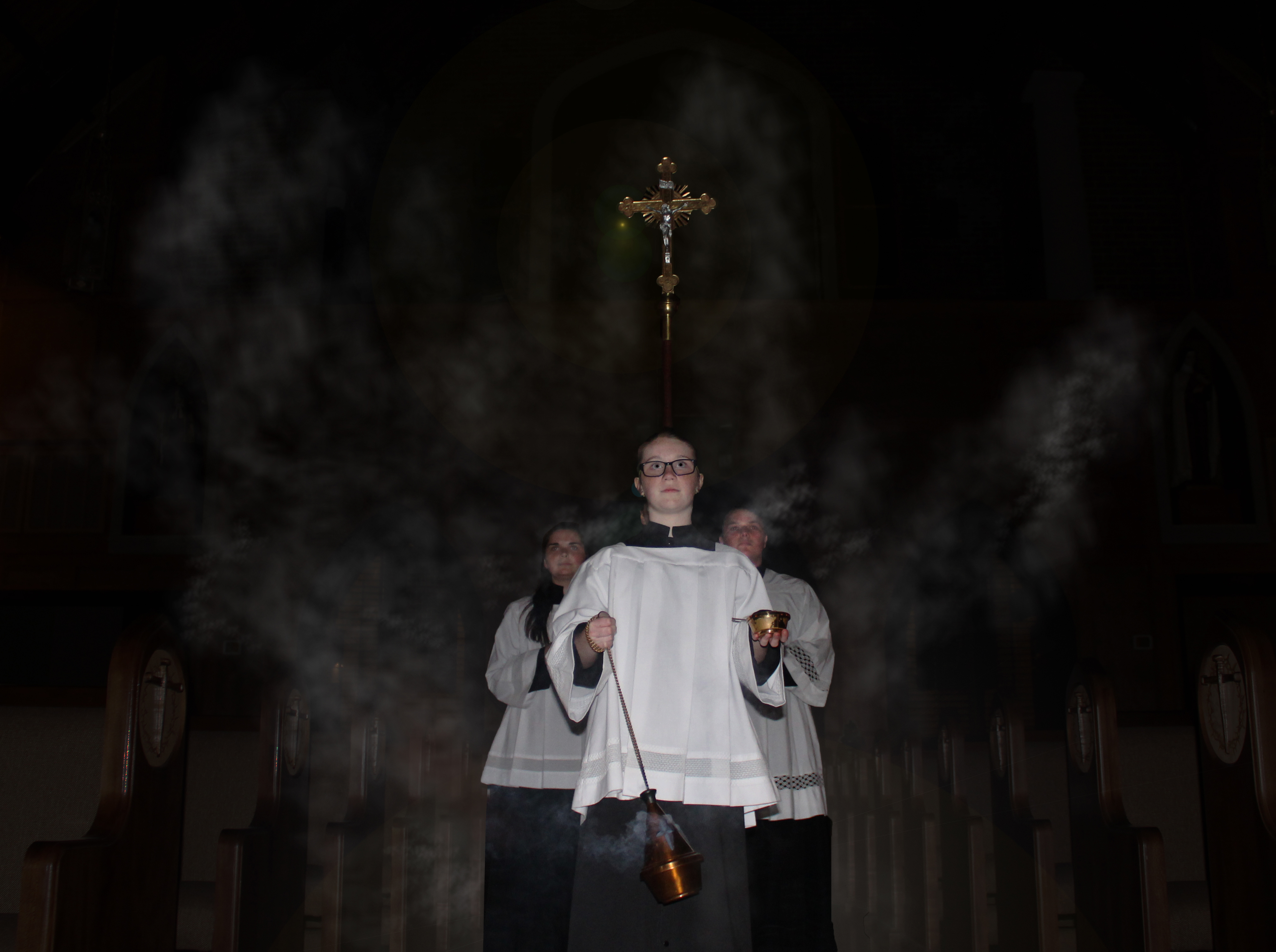
Catholicism is sometimes called the religion of ‘bells & smells’. The Tradition of Mother Church engages the whole person. God created us a unity of body and soul and as such, our worship includes our bodily and spiritual senses. We hear it, see it, feel it, taste it, and smell it as well. We ring bells to HEARLD the Lord’s appearance and we burn fragrant incense before His Altar.
The prophet Malachi (1:11) foretold a day when ‘from the rising of the sun to its setting... in every place incense is offered to My name, a pure offering’. In the exodus, the high priest Aaron states that God said, ‘I chose him out of all the tribes of Israel to be my priest, to go up to my altar, to burn incense’ (1 Sam. 2:28). And as such, the priest from the time of Moses to the time of Jesus and beyond, Jesus; kinsman Zechariah was performing his priestly duty of burning incense in the Temple, when the angel Gabriel appeared to him. It was apparently customary for a ‘whole multitude of the people’ to pray nearby ‘at the hour of incense’ every day (Luke 1:9-11).
Psalm 141:2 ... ‘let my prayer be counted as incense before you’
Jeremiah 1:16 ... ‘I will utter my judgments against them, for all their wickedness in forsaking me; they have burned incense to other gods, and worshiped the works of their own hands.’
May all of our prayers be much like that of the saints...
Rev 8:3-4 ... ‘The prayers of the saints on earth, he says, rise as incense to heaven.’
*Signs of Life, by Scott Hahn (incense)


An American tourist complimented a Mexican fisherman on the quality of his fish and asked him how long it took him to catch them.
“Not very long,” answered the Mexican.
“But then, why didn’t you stay out longer and catch more?” asked the American.
The Mexican explained that his small catch was sufficient to meet his needs and those of his family.
The American asked “But what do you do with the rest of your time?”
“I sleep late, fish a little, play with my children, take a siesta with my wife. In the evenings, I go into the village to see my friends, have a few drinks, play the guitar, and sing a few songs. I have a full life.”
The American interrupted, “I have an MBA from Harvard and I can help you! You should start by fishing longer every day. You can then sell the extra fish you catch. With the extra revenue, you can buy a bigger boat.”
“And after that?” asked the Mexican.
“With the extra money the larger boat will bring, you can buy a second one and a third one and so on until you have an entire fleet of trawlers. Instead of selling your fish to a middle man, you can then negotiate directly with the processing plants and maybe even open your own plant. You can then leave this little village and move to Mexico City, Los Angeles, or even New York City! From there you can direct your huge new enterprise.”
“How long would that take?” asked the Mexican.
“Twenty, perhaps twenty-five years,” replied the American.
“And after that?”
“Afterwards? Well my friend, that’s when it gets really interesting,” answered the American, laughing. “When your business gets really big, you can start buying and selling stocks and make millions!”
“Millions? Really? And after that?” asked the Mexican.
“After that you’ll be able to retire, live in a tiny village near the coast, sleep late, play with your children, catch a few fish, take a siesta with your wife and spend your evenings drinking with your friends.”
Know where you’re going in life... You may already be there.

